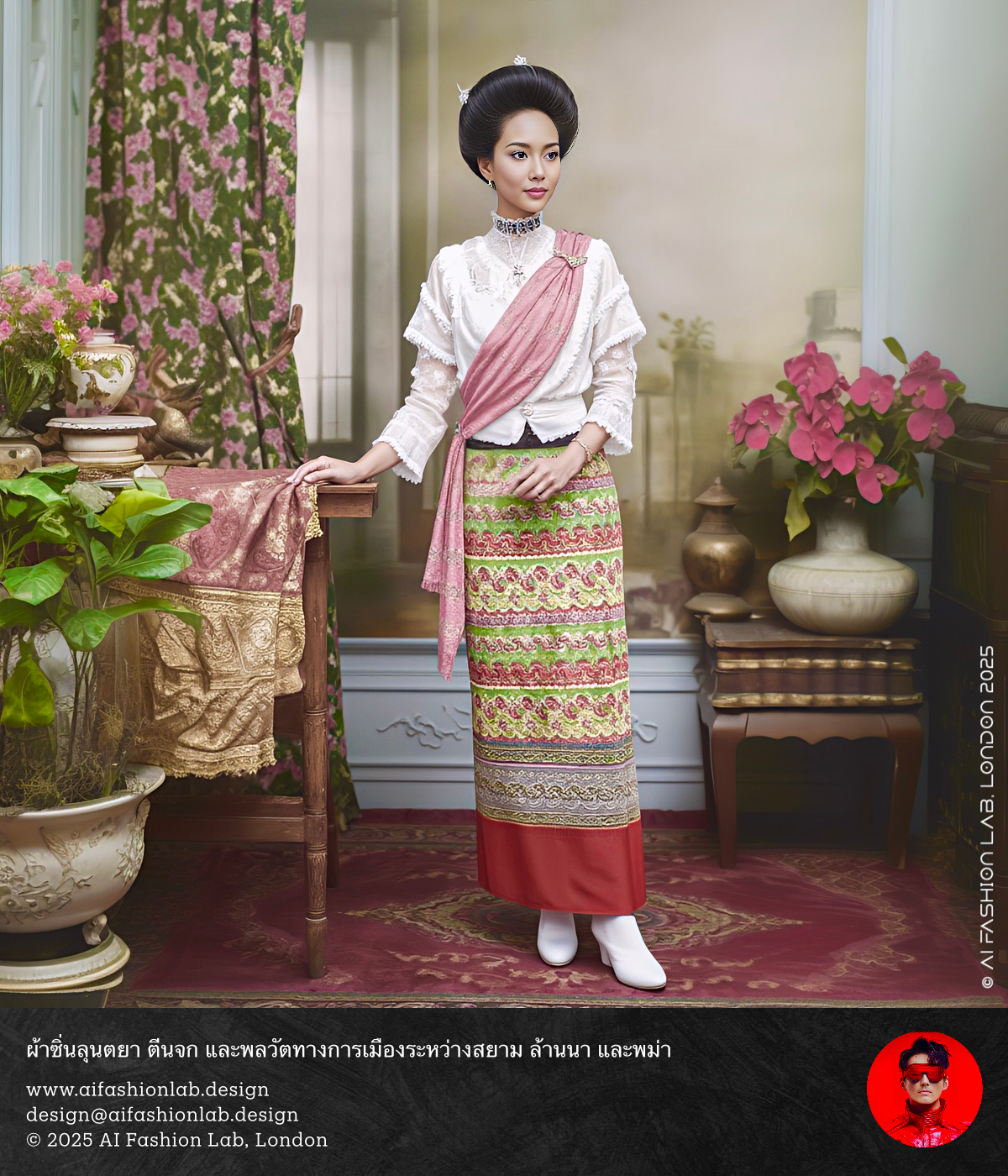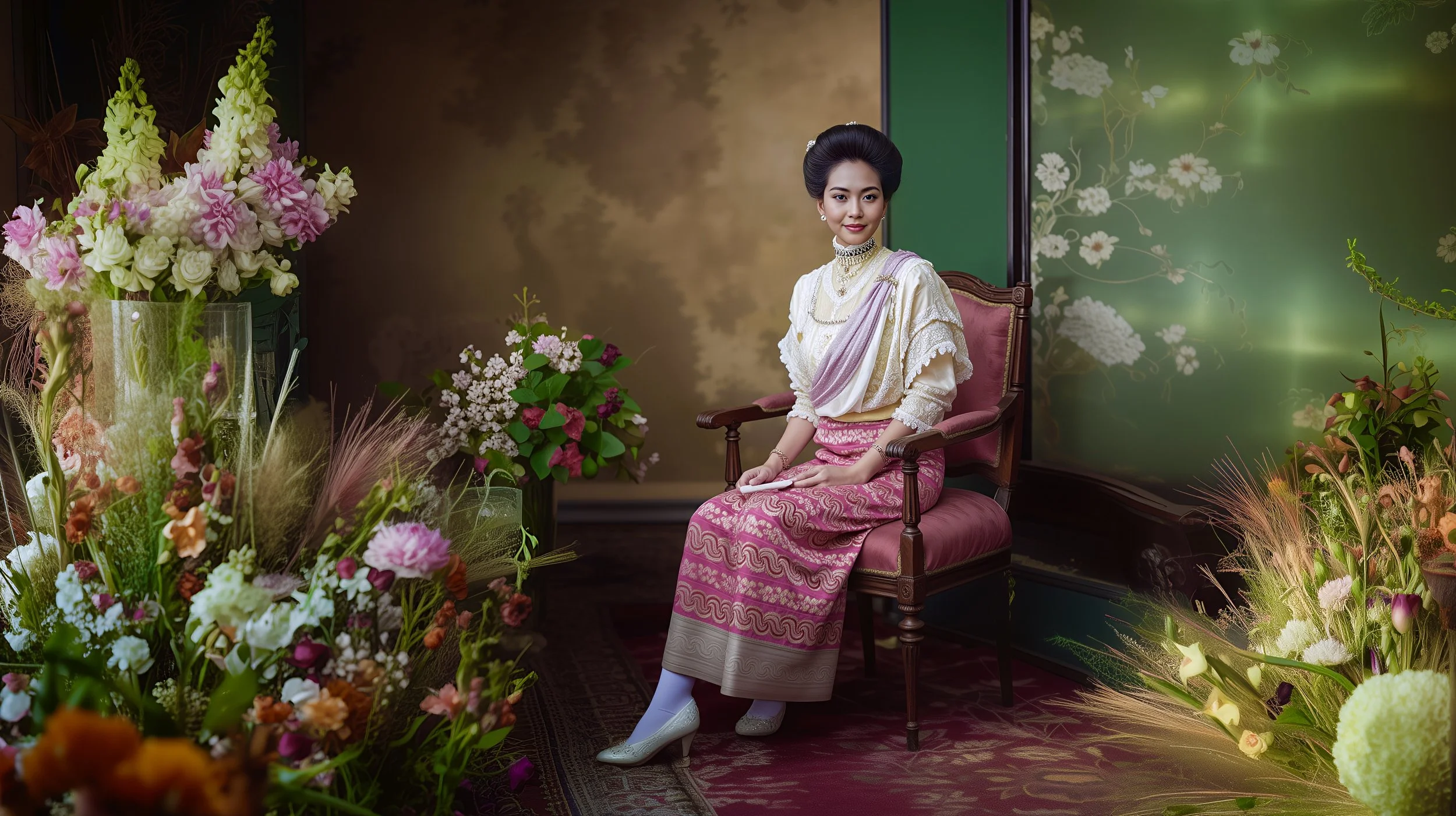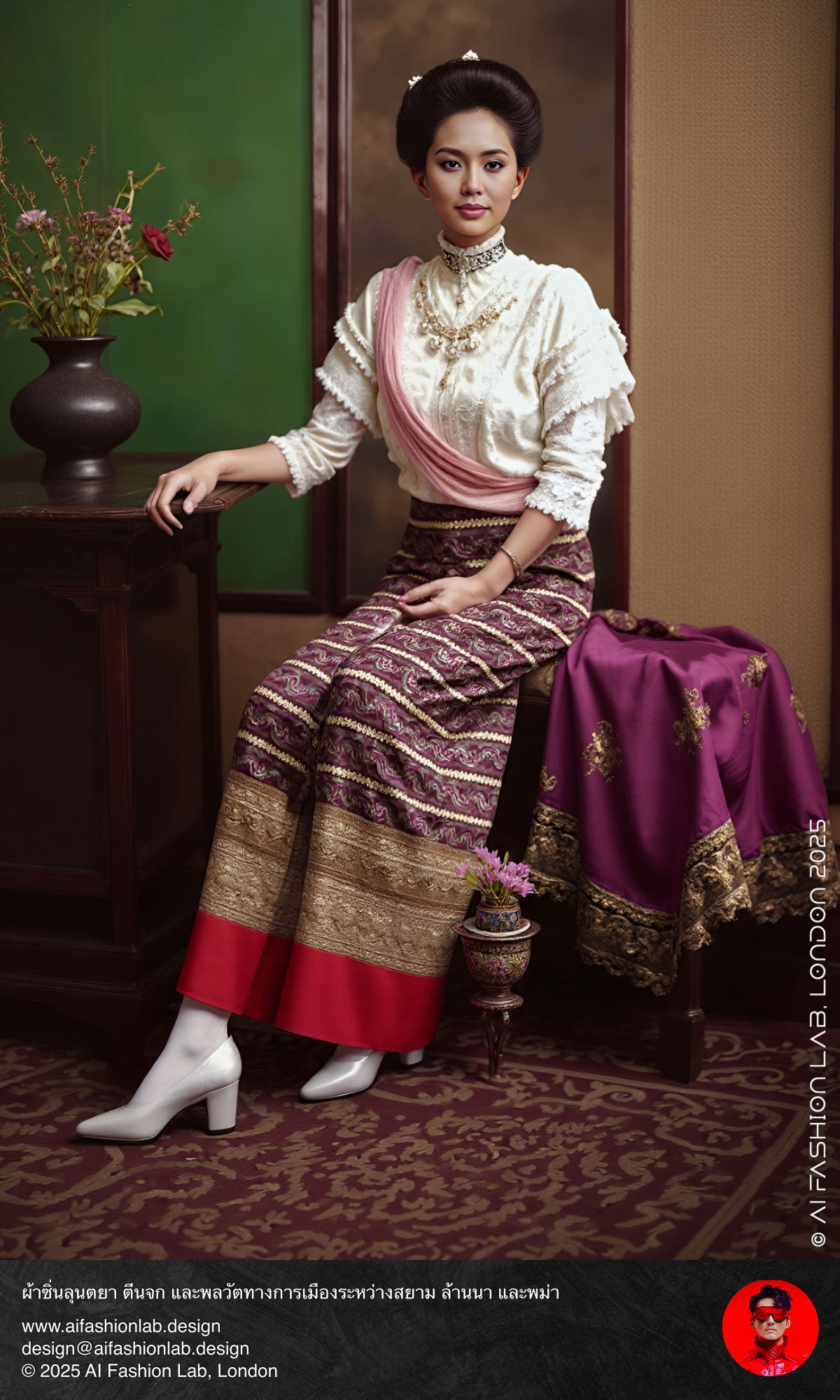Studying Historical Attire through AI Modeling: Burmese Luntaya Acheik, Lanna Teen Jok Hem Border, and the Political Dynamics of Siam, Lanna, and Burma
The use of AI to generate images of Pha-Sin Luntaya with a Lanna Teen Jok Hem Border serves as an experimental approach to studying how fashion intersects with political history.
Studying Historical Attire through AI Modeling: Burmese Luntaya Acheik, Lanna Teen Jok Hem Border, and the Political Dynamics of Siam, Lanna, and Burma
1. Introduction: AI Technology and the Study of Historical Fashion
This collection is an effort to train an AI model to study historical fashion, focusing on the Luntaya Acheik (Burmese Luntaya Acheik tubular skirt), a fashion trend initiated by Princess Consort Dara Rasmi. She integrated the Burmese Luntaya Acheik textile with the Lanna Teen Jok Hem Border (a traditional Lanna weaving technique featuring intricate handpicked supplementary weft patterns, typically used to decorate the hem of Pha-Sin skirts), creating a distinctive hybrid style that carried profound political and cultural significance during the transitional period in relations between Siam, Lanna, and Burma (then under British colonial rule).
Although several LoRA AI models have been trained to replicate the Luntaya Acheik wave patterns, the intricate details remain difficult to fully capture due to their high level of complexity and delicate weaving techniques. However, the latest results represent the most accurate visualisations achieved so far. Other elements, such as Edwardian fashion details—including upswept hairstyles and lace blouses—are rendered with high precision.
To enhance accuracy, this collection incorporates real photographs of Burmese Luntaya Acheik textiles alongside AI-generated Luntaya patterns trained using LoRA models and original photographs of Princess Consort Dara Rasmi in her Edwardian lace blouse and Pha-Sin Luntaya with Lanna Teen Jok Hem Border as reference materials.
2. Religious and Cosmological Symbolism of Luntaya Acheik Patterns
Burmese Luntaya Acheik textiles are not only an expression of artistic and fashion aesthetics but also hold deep Buddhist religious and cosmological significance. Thai historian Paothong Thongchua describes the symbolism of the wave-like motifs on Luntaya Acheik as follows:
“The wave pattern on this Luntaya Acheik textile carries profound meaning, representing the sacred Sattaboriphan mountains... The layered wave motifs symbolise the peaks of the Sattaboriphan mountains and the great oceans surrounding Mount Meru. The highest peak corresponds to the position of the bun on a Burmese woman’s head, signifying Mount Meru—the cosmic centre of the universe, where Lord Indra and celestial beings reside. Traditional Burmese women style their hair in an elegant bun and adorn it with flowers not merely for beauty but as an offering to the divine.” (Paothong Thongchua, Krungthep Turakij, May 30, 2022)
Based on this belief, when Burmese women wear Pha-Sin Luntaya, it is as if they are embodying the cosmic structure on their own bodies. The seven-layered wave pattern represents the seven Sattaboriphan mountain ranges encircling Mount Meru, the sacred abode of Lord Indra in Buddhist and Hindu cosmology.
3. Political Context: The Relationship Between Siam and Lanna and the Role of British Burma
3.1 The Complex Relationship Between Siam and Lanna
Lanna was once an independent kingdom but came under Burmese rule for several centuries before Siam successfully reclaimed control over Lanna in the late 18th century. However, Lanna retained its distinct identity and was not fully integrated into Siam.
During the reign of King Chulalongkorn (Rama V), efforts were made to bring Lanna under direct Siamese administration. Siam established a suzerainty system, allowing Lanna’s ruling class to retain some autonomy. The rulers of Chiang Mai, including King Inthawichayanon (r. 1873–1897), maintained control over the region while acknowledging Siamese sovereignty.
However, by the late 19th century, Siam sought to accelerate the "Siamisation" process, aiming to fully incorporate Lanna into its administrative framework. This led to tensions between Siamese central authority and Lanna’s noble class, who sought to preserve their regional autonomy.
3.2 Why Lanna Might Have Considered Seeking Support from British Burma
At the time, Burma had become a British colony (British Burma), and Britain was actively expanding its influence in the Greater Mekong region. If Lanna wished to avoid Siamese control, seeking British protection could have been a strategic option.
Historical records indicate that Britain had a vested interest in Lanna, particularly as Siam faced increasing pressure from French colonial expansion in Laos. The British saw Lanna as a potential "buffer state" to counterbalance French territorial ambitions.
A contemporary account suggests that Queen Victoria of England allegedly sent envoys to negotiate with King Inthawichayanon of Chiang Mai, proposing to adopt Princess Dara Rasmi as a royal daughter and establish her as "Princess of Chiang Mai" under British protection. Although there is no definitive evidence confirming this claim, it reflects the broader geopolitical tensions between Siam, Lanna, and the British Empire.
4. The Political Symbolism of Pha-Sin Luntaya and the Lanna Teen Jok Hem Border
4.1 The Meaning Behind Princess Dara Rasmi’s Fashion Choice
The decision of Princess Consort Dara Rasmi to wear a Pha-Sin Luntaya with a Lanna Teen Jok Hem Border was likely more than just a stylistic preference; it may have been a political statement during the shifting power dynamics between Siam, Lanna, and Burma.
The integration of Burmese Luntaya Acheik textiles with Lanna Teen Jok weaving could symbolise Lanna’s attempt to maintain its unique cultural identity despite being under Siamese suzerainty.
Wearing a fusion of Burmese and Lanna textiles in the Siamese royal court may have been a subtle assertion that Lanna was not yet fully assimilated into Siam.
5. The Role of King Inthawichayanon and the Political Implications of Princess Dara Rasmi’s Relocation to Siam
5.1 Why Princess Dara Rasmi Was Sent to Bangkok
During the reign of King Inthawichayanon (r. 1873–1897), Lanna remained under Siamese influence but was still a semi-autonomous state. To secure Siam’s hold over Lanna, King Chulalongkorn (Rama V) requested that Princess Dara Rasmi be sent to Bangkok as a royal consort.
At the time, rumours circulated that Britain might adopt Princess Dara Rasmi as a royal daughter to strengthen its influence in Lanna. If this had happened, Lanna could have sought protection under British rule rather than being fully incorporated into Siam. To preempt this possibility, King Chulalongkorn persuaded King Inthawichayanon to send Princess Dara Rasmi to the Siamese court.
6. Conclusion: AI and the Study of Political Fashion
The use of AI to generate images of Pha-Sin Luntaya with a Lanna Teen Jok Hem Border serves as an experimental approach to studying how fashion intersects with political history.
Burmese Luntaya Acheik textiles were not just beautiful woven patterns but also embodied Buddhist cosmology and expressions of power. Likewise, Princess Dara Rasmi’s fashion choices may have carried a deeper political message, symbolising Lanna’s identity amid imperial pressures from Siam and Britain.
While AI still has limitations in precisely replicating the intricate wave patterns of Luntaya Acheik textiles, this collection marks an important step toward using artificial intelligence as a tool for studying historical attire and its socio-political contexts.
การศึกษาเครื่องแต่งกายทางประวัติศาสตร์ผ่านแบบจำลองปัญญาประดิษฐ์: ผ้าซิ่นลุนตยา ตีนจก และพลวัตทางการเมืองระหว่างสยาม ล้านนา และพม่า
คอลเลกชันนี้เป็นความพยายามในการฝึกแบบจำลองปัญญาประดิษฐ์ (AI) เพื่อศึกษาประวัติศาสตร์แฟชั่น โดยมุ่งเน้นไปที่กระแสนิยมของ ผ้าซิ่นลุนตยา ซึ่งเริ่มต้นขึ้นโดย พระราชชายา เจ้าดารารัศมี ที่นำ ผ้าลุนตยา อะฉิก (Luntaya Acheik) ของพม่ามาผสมผสานกับ ตีนจกยกดิ้นจากเชียงใหม่ อัตลักษณ์การแต่งกายนี้มีความหมายทางการเมืองและวัฒนธรรมอย่างลึกซึ้งในช่วงเปลี่ยนผ่านความสัมพันธ์ระหว่าง สยาม ล้านนา และพม่า (ภายใต้อาณานิคมของอังกฤษ)
แม้ว่าการฝึกแบบจำลอง LoRA หลายชุดจะสามารถจำลองลักษณะของผ้าลุนตยาได้ในระดับหนึ่ง แต่ รายละเอียดของลายคลื่น (Acheik Wave Patterns) ยังคงไม่สามารถจำลองได้อย่างสมบูรณ์ เนื่องจากความประณีตของลวดลายที่ซับซ้อนและละเอียดอ่อน อย่างไรก็ตาม ผลลัพธ์จากแบบจำลองล่าสุดถือเป็นภาพที่ดีที่สุดในการฝึกฝนครั้งนี้ องค์ประกอบอื่น ๆ เช่น แฟชั่นยุคเอ็ดเวิร์ดเดียน (Edwardian Fashion) ไม่ว่าจะเป็น ทรงผมเกล้ามวยสูงและเสื้อลูกไม้ ยังคงถูกสร้างขึ้นได้อย่างแม่นยำ
เพื่อเสริมความถูกต้องของแบบจำลอง คอลเลกชันนี้ได้เพิ่ม ภาพถ่ายจริงของผ้าลุนตยา และ ภาพลายผ้าที่ได้จากการสร้างด้วย AI ผ่าน LoRA ที่ฝึกฝนเพื่อสร้างภาพลายลุนตยา รวมถึง ภาพต้นฉบับของพระราชชายา เจ้าดารารัศมี ในชุดเสื้อลูกไม้เอ็ดเวิร์ดเดียนและ ผ้าซิ่นลุนตยาต่อด้วยตีนจก เพื่อเป็นข้อมูลอ้างอิง
สัญลักษณ์ทางศาสนาและจักรวาลวิทยาของลวดลายลุนตยา
ผ้าลุนตยาไม่เพียงเป็นสิ่งสะท้อนความงามในเชิงศิลปะและแฟชั่น แต่ยังมีความหมายทางศาสนาและจักรวาลวิทยาของชาวพุทธ โดย เผ่าทอง ทองเจือ อธิบายความหมายของลายคลื่นบนผ้าลุนตยาไว้ว่า
“ลายคลื่นของผ้าลุนตยาผืนนี้เป็นผ้าที่มีความหมายดีมาก เป็นเรื่องเขาสัตตบริภัณฑ์... ลายคลื่นบนผ้าทอลุนตยาที่ซ้อนเป็นชั้นๆ จึงเปรียบเสมือนสัญลักษณ์ยอดเขาสัตตบริภัณฑ์และห้วงมหาสมุทรที่ล้อมรอบเขาพระสุเมรุบนมุ่นมวยผมที่อยู่สูงสุดของร่างกายนั่นเอง ถือเป็นลายทอที่ทอเพื่อบูชาเทพยดาโดยแท้” (เผ่าทอง ทองเจือ, กรุงเทพธุรกิจ, 30 พฤษภาคม 2022)
จากแนวคิดดังกล่าว การที่สตรีพม่าสวมใส่ ผ้าซิ่นลุนตยา จึงเป็นเสมือนการจำลอง ความเป็นศูนย์กลางแห่งจักรวาลบนเรือนร่างของตน โดย ลายคลื่นเจ็ดชั้นบนผืนผ้าแทนหมู่เขาสัตตบริภัณฑ์ ที่ล้อมรอบ เขาพระสุเมรุ ซึ่งเป็นที่สถิตของพระอินทร์และเหล่าเทวดาตามคติพราหมณ์-พุทธ
บริบทความสัมพันธ์ระหว่างสยามกับล้านนา และความเป็นไปได้ที่ล้านนาอาจหันไปพึ่งพม่า-อังกฤษ
1. ความสัมพันธ์ที่ซับซ้อนระหว่างสยามและล้านนา
ล้านนาเคยเป็นอาณาจักรที่มีอิสรภาพ แต่ภายหลังการถูกพม่าปกครองมาหลายร้อยปี สยามสามารถยึดครองล้านนาได้สำเร็จในช่วงปลายคริสต์ศตวรรษที่ 18 อย่างไรก็ตาม ล้านนายังคงมี เอกลักษณ์เฉพาะตัว และไม่ได้รวมเป็นส่วนหนึ่งของสยามอย่างสมบูรณ์
แม้ว่ารัชกาลที่ 5 จะพยายามรวมล้านนาเข้ากับสยามผ่านการส่งข้าหลวงขึ้นไปปกครองแทนเจ้าผู้ครองนคร ระบบการปกครองของสยามในล้านนายังคงมีลักษณะเป็น "รัฐประเทศราช" ซึ่งทำให้ เจ้าผู้ครองนครเชียงใหม่ยังคงมีบทบาทในฐานะศูนย์กลางอำนาจของล้านนา
อย่างไรก็ตาม ช่วงปลายคริสต์ศตวรรษที่ 19 สยามเริ่มเร่งกระบวนการ การผนวกล้านนาเข้ากับอำนาจส่วนกลาง ทำให้เกิดความขัดแย้งกับกลุ่มเจ้านายล้านนาที่ต้องการรักษาอำนาจของตนเอง
2. เหตุใดล้านนาอาจมองพม่า-อังกฤษเป็นทางเลือก
ช่วงเวลานั้น พม่าตกเป็นอาณานิคมของอังกฤษ (British Burma) และอังกฤษมีนโยบายขยายอิทธิพลในดินแดนภูมิภาคลุ่มแม่น้ำโขง หากล้านนาแสดงจุดยืนไม่ต้องการอยู่ใต้การปกครองของสยาม การขอความช่วยเหลือจากอังกฤษอาจเป็นทางเลือกทางการเมืองที่มีความเป็นไปได้
มีบันทึกว่าอังกฤษเคยให้ความสนใจในล้านนา โดยเฉพาะในช่วงที่สยามกำลังเผชิญกับแรงกดดันจากจักรวรรดิฝรั่งเศสที่ขยายอิทธิพลเข้าสู่ลาว อังกฤษอาจมองล้านนาเป็น "รัฐกันชน" ที่สามารถใช้เป็นฐานอำนาจในการคานอำนาจของฝรั่งเศส
มีหลักฐานจากแหล่งข้อมูลร่วมสมัยที่กล่าวถึง ข่าวลือว่าสมเด็จพระราชินีนาถวิกตอเรียแห่งอังกฤษเคยส่งทูตมาเจรจากับพระเจ้าอินทวิชยานนท์ (เจ้าหลวงเชียงใหม่, ครองราชย์ พ.ศ. 2416–2440) เพื่อขอให้ เจ้าดารารัศมีเป็นพระราชธิดาบุญธรรม และสถาปนาเป็น "เจ้าหญิงแห่งเชียงใหม่" ภายใต้จักรวรรดิอังกฤษ แม้ว่าไม่มีหลักฐานยืนยันแน่ชัด แต่เหตุการณ์นี้สะท้อนถึงความสัมพันธ์เชิงอำนาจระหว่างล้านนา สยาม และอังกฤษในเวลานั้น
พระเจ้าอินทวิชยานนท์ กษัตริย์เชียงใหม่และบริบททางการเมืองของเจ้าดารารัศมี
ในรัชสมัยของ รัชกาลที่ 5 กษัตริย์แห่งเชียงใหม่คือ พระเจ้าอินทวิชยานนท์ (ครองราชย์ พ.ศ. 2416–2440) พระองค์เป็นเจ้าหลวงเชียงใหม่ลำดับที่ 7 และเป็นพระบิดาของ เจ้าดารารัศมี
ช่วงเวลานั้น ล้านนาอยู่ภายใต้อิทธิพลของสยาม แต่ยังคงมี ความเป็นรัฐกึ่งอิสระ ซึ่งทำให้สยามต้องใช้วิธีทางการเมืองในการรวบอำนาจอย่างแนบเนียน หนึ่งในยุทธศาสตร์สำคัญคือ การเชื่อมสัมพันธ์กับราชวงศ์เชียงใหม่ผ่านการอภิเษกสมรส
1. ข่าวลือเรื่องการรับเลี้ยงของอังกฤษ และเหตุผลที่ส่งเจ้าดารารัศมีไปสยาม
ในช่วงปลายศตวรรษที่ 19 อังกฤษมีอิทธิพลเหนือพม่าและกำลังขยายอำนาจในเอเชียตะวันออกเฉียงใต้ มีข่าวลือว่า สมเด็จพระราชินีนาถวิกตอเรียแห่งอังกฤษ สนใจให้ล้านนาเป็นรัฐในอารักขาของอังกฤษ และมีรายงานว่า อังกฤษอาจรับเจ้าดารารัศมีเป็นพระราชธิดาบุญธรรม เพื่อสร้างอิทธิพลในภูมิภาค
รัชกาลที่ 5 ทรงตระหนักว่าหากอังกฤษรับเจ้าดารารัศมีเป็นพระราชธิดาบุญธรรมจริง อาจทำให้ล้านนามีสถานะที่แข็งแกร่งขึ้น และอาจเลือกแยกตัวออกจากอิทธิพลของสยาม ในการตอบโต้ รัชกาลที่ 5 ทรงขอให้พระเจ้าอินทวิชยานนท์ส่งเจ้าดารารัศมีมาทำราชกาลฝ่ายใน จากนั้น พ.ศ. 2429 ก็มีการถวายตัวเจ้าดารารัศมีอย่างเป็นทางการ โดยทรงเป็นพระภรรยาเจ้าเพียงพระองค์เดียวที่มาจากประเทศราช ในขณะที่อีก 8 พระองค์ทรงเป็นพระภรรยาเจ้าชั้นลูกหลวงและชั้นหลานหลวง (“ลูก” และ “หลาน” ของพระมหากษัตริย์พระองค์ก่อนๆ)
2. การเป็นพระราชชายาในสยาม: ตัดโอกาสที่ล้านนาจะอยู่ใต้อิทธิพลอังกฤษ
เจ้าดารารัศมีเสด็จมายังกรุงเทพฯ ในปี พ.ศ. 2429 และได้รับตำแหน่งเป็น พระราชชายาในรัชกาลที่ 5 การอภิเษกครั้งนี้ ไม่ได้เป็นเพียงเรื่องความสัมพันธ์ส่วนพระองค์ แต่เป็นการเชื่อมโยงทางการเมืองที่ชัดเจน
ทำให้ล้านนาใกล้ชิดกับสยามมากขึ้น และลดความเสี่ยงที่ล้านนาจะขอความช่วยเหลือจากอังกฤษ
ตัดข่าวลือเรื่องการรับเจ้าดารารัศมีเป็นพระราชธิดาบุญธรรมของสมเด็จพระราชินีนาถวิกตอเรียแห่งอังกฤษ ทันที เนื่องจากการที่พระราชชายาเจ้าดารารัศมีเป็นส่วนหนึ่งของราชสำนักสยาม ทำให้ไม่มีสถานะที่อังกฤษสามารถแทรกแซงได้
นอกจากนี้ สยามยังได้ ปรับโครงสร้างการปกครองล้านนา ให้เข้าสู่ระบบ "มณฑลเทศาภิบาล" ในเวลาต่อมา ลดอำนาจของเจ้านายล้านนาและรวมล้านนาเข้าเป็นส่วนหนึ่งของสยามอย่างเป็นทางการ
การเมืองของผ้าซิ่น: การผสมผสานระหว่างผ้าลุนตยากับตีนจกล้านนา
การที่ พระราชชายา เจ้าดารารัศมี ทรงสวม ผ้าซิ่นลุนตยาต่อด้วยตีนจก เป็นสิ่งที่นักประวัติศาสตร์ล้านนาตีความว่ามี นัยทางการเมือง แฝงอยู่ในช่วงหัวเลี้ยวหัวต่อของยุค รัชกาลที่ 5-6
1. ความอ่อนไหวทางการเมืองระหว่างสยาม-ล้านนา-พม่า
ในช่วงปลายศตวรรษที่ 19 ล้านนาเป็นดินแดนที่ทั้งสยามและพม่าต่างต้องการครอบครอง สยามต้องการผนวกล้านนาให้เป็นส่วนหนึ่งของราชอาณาจักรอย่างสมบูรณ์ ขณะที่พม่าตกอยู่ภายใต้การปกครองของ อังกฤษ และอาจกลายเป็นพันธมิตรทางเลือกสำหรับล้านนา
การที่ เจ้าดารารัศมีทรงสวมผ้าซิ่นลุนตยา จึงอาจเป็นการส่งสัญญาณถึง ความสัมพันธ์ระหว่างล้านนาและพม่า ซึ่งต่างอยู่ในสถานะรัฐกันชนที่ถูกช่วงชิงจากสองมหาอำนาจในภูมิภาค
2. ความหมายแฝงของตีนจกล้านนา
ผ้าตีนจกเป็นสัญลักษณ์ของล้านนา ไม่เคยมีเจ้านายฝ่ายเหนือพระองค์ใดทรงสวมผ้าซิ่นลุนตยาแบบราชนารีพม่ามาก่อน การที่ เจ้าดารารัศมีทรงนำผ้าตีนจกมาต่อกับผ้าลุนตยา จึงอาจเป็นการแสดงออกถึง อัตลักษณ์ล้านนา และส่งสัญญาณให้สยามเห็นว่า ล้านนายังสามารถเลือกข้างทางการเมืองของตนเองได้
บทสรุป
การใช้ปัญญาประดิษฐ์เพื่อสร้างภาพ ผ้าซิ่นลุนตยาต่อด้วยตีนจก เป็นการศึกษาผ่านการทดลองที่เชื่อมโยง ประวัติศาสตร์แฟชั่นกับบริบททางการเมือง ผ้าลุนตยาไม่เพียงเป็นสิ่งงดงามทางศิลปะ แต่ยังสะท้อนถึงความเชื่อ ศาสนา และอำนาจของชนชั้นสูงพม่า
การที่ เจ้าดารารัศมี ทรงนำผ้าลุนตยามาประยุกต์กับ ตีนจกล้านนา อาจเป็นมากกว่าการเลือกสวมใส่เสื้อผ้า หากแต่เป็น ถ้อยแถลงทางการเมืองที่สะท้อนอัตลักษณ์ล้านนา ท่ามกลางแรงกดดันของจักรวรรดิในภูมิภาค
แม้ AI ยังมีข้อจำกัดในการจำลองลายผ้า แต่คอลเลกชันนี้ถือเป็นก้าวสำคัญในการใช้เทคโนโลยีเพื่อศึกษาประวัติศาสตร์เครื่องแต่งกายและบริบททางสังคม-การเมืองที่แฝงอยู่ในแฟชั่นแห่งยุคสมัย
#aifashionlab #AI #aiartist #aiart #aifashion #aifashiondesign #aifashionstyling #aifashiondesigner #fashion #fashionhistory #historyoffashion #fashionstyling #fashionphotography #digitalfashion #digitalfashiondesign #digitalcostumedesign #digitaldesign #digitalaiart #bangkok #bangkokthailand #chiangmai #lanna #ThaiFashionHistory #ThaiFashionAI #flux #fluxlora





















































